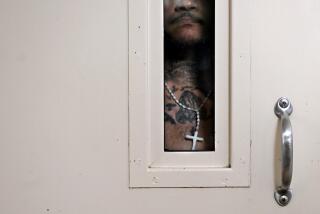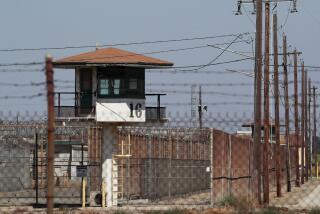Mass release of California prisoners weighed by judges amid coronavirus fears
- Share via
As parole dates are sped up and inmates tear shirts and socks to make masks, federal judges are weighing whether California must take larger, more drastic steps to avert the spread of COVID-19 in its teeming prisons.
“There is injury and despair” among inmates living in crowded dorms under threat of the coronavirus, attorney Sarah Norman with the Prison Law Office said during an emergency hearing Thursday before three federal judges.
The remedies that inmate lawyers propose range from mass releases to the state’s use of empty buildings and acquisition of property to temporarily house inmates — akin to COVID-19 measures to house cruise ship passengers and the homeless.
Lawyers for Gov. Gavin Newsom contend that federal intervention is unwarranted and mass prison releases might endanger the public by overloading already struggling community hospitals.
“We should be afforded the opportunity granted to us to attempt social distancing,” said Paul Mello, a private attorney representing the governor’s office. “We can move people into gyms.... We can move people into vacant facilities. We should be afforded the opportunity to do those things.”
Mello said there is no constitutional requirement for six-foot social distancing within the prison. Nor did he know if the state has plans to reach that goal.
U.S. District Judge Kimberly Mueller, sitting in Sacramento, pressed California’s lawyer on whether inmates should have the same chance at social distancing as the rest of the citizenry, as a matter of “decency.” He did not answer.
But Mello said it would be a “red herring” to raise fears of increased crime and that recidivism was not a part of the state’s objections to prison releases.
The federal judges have not said when they will rule on the emergency motion brought by lawyers representing prisoners.
California already shut off visitation and volunteer programs, halted the admission of an expected 3,000 new inmates waiting in county jails, and began screening workers as they enter prisons. With those measures, the spread of the coronavirus has been somewhat limited and more than half the state’s 35 prisons had no reported cases of COVID-19.
As of April 2, the corrections department reported infections of 33 prison workers and eight inmates in 16 prisons. However, inmate testing is spotty, with only eight inmates screened at a Chino prison despite infection of 11 prison workers.
California’s lawyers contend plans for housing, programming and public benefits have already begun for 3,500 inmates to be released early in the next two months, thereby lessening the impact on home communities and county probation offices.
The court-appointed chief of prison medical care, J. Clark Kelso, told prison administrators in an email last week that he supports an “immediate, substantial reduction” in the prison population, but focused on inmates who have homes and families to return to.
For those who don’t, Kelso wrote, “an early release is unlikely to improve the inmates’ environment from a healthcare perspective and may increase the COVID-19 risk in the community of release.”
State lawyers also argue in court papers that a large release would hamper programs to help the homeless and burden hospitals.
“Community hospitals, social services and safety nets and other infrastructure are highly stressed, struggling mightily to address the current needs of the community,” they said. “A mass release could further add to the strain the free world healthcare system is under right now.”
But the state prison system already relies on many of those same community hospitals for high-level patient care, state lawyers acknowledged. And it is unclear if prisons have the resources to deal with inmates whose lungs are attacked by COVID-19.
The federal receiver’s office, which has overseen inmate care since 2006, told The Times it has no records reflecting the number of ventilators within the prison system. A lead attorney in longstanding federal litigation with the state said he believes the number is zero.
In the news
Some 46,000 inmates live in open dorms with bunks two feet apart. The prison medical system reports that 45,000 of the state’s 120,000 inmates — 37% —have at least one health risk to COVID-19 infection, including 14,700 inmates with asthma.
California plans to move some 500 inmates out of open dorms to alternative housing that includes beds set up in gymnasiums, a return to a practice California used during the height of prison crowding. Prison laborers have also been asked to manufacture hand sanitizer for the prison system.
Several inmates, speaking directly or through family members, have told The Times they feel at risk. They describe elderly, infirm and young inmates crowded together in dorms with shortages of soap and lack of access to sanitizing chemicals and some are fashioning their own protective gear.
“My dad said guys are now making masks out of anything they can, shirts, socks...” said a woman whose father is at the California Institution for Men in Chino, where 12 people have tested positive for COVID-19.
Prison systems nationwide have been under pressure for weeks to step up their efforts. The response has been mixed.
The federal Bureau of Prisons on Wednesday announced a 14-day soft lockdown at its 122 prisons, permitting some access to educational and mental health programs but confining most inmates to their cells after an inmate died at a penitentiary in Louisiana.
Several California prison medical and corrections officers have told The Times that despite public proclamations of social distancing and increased sanitation, life on the prison yard remains unaltered.
“Just yesterday I witnessed large groups of inmates together on the yard while on the other side of the yard 20 +/- correctional officers all gathered together for a potluck dinner,” one prison employee wrote, speaking anonymously because he said he feared losing his job for discussing prison conditions without authorization.
“Earlier in the week there were a handful of inmates put on quarantine for symptoms then taken off 3 days later,” he said.
Prison records provided to The Times by another source corroborate that account. They show multiple cell blocks locked down when clusters of inmates develop flu-like symptoms, and returned to normal activity a week later.
“Nothing about this pandemic is being taken seriously,” the state employee said, “and thousands of inmates and workers are in great danger.”
More to Read
Sign up for Essential California
The most important California stories and recommendations in your inbox every morning.
You may occasionally receive promotional content from the Los Angeles Times.











